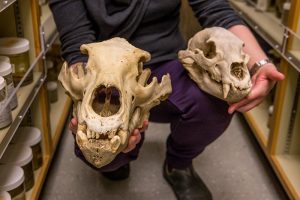By: Umer Altaf
Unknown to most students and hidden behind the dreary hallways of the Shrum Science Centre, an immaculate organisms collection resides within our university. Magnificently curated and remarkably comprehensive, the Biological Sciences Teaching Collection is likely the most fascinating thing at this school you’ve never heard of. Last week I got a chance to sit down with Tiia Haapalainen, the current teaching and collections technician at the facility, and ask her what exactly they are hiding in this place.

Tiia manages the facility and is responsible for providing teaching support and curating the collection, among other things. Her love for this place and the work that she does is obvious. As she began walking me through the facility, the scope of the endeavour slowly began creeping up on me. Walking past row after after row of shelves filled with countless encasements did little justice to the scale of this place. To expect to have a feel for the facility by simply walking past it was like trying to walk through a bookstore expecting to understand every book: utterly impossible. The exhibits include everything from articulated skeletons, to rare egg shells and nests, to even wholly preserved animals. Entire collection of preserved birds ranging from eagles to swans to owls lay neatly in drawers stacked close to the ceiling. Box after box was stored containing a massive collection of insects ranging from stunning butterflies to skin-crawling beetles. Perhaps most unnerving of all was the quasi-graveyard of skulls and bones collected from majestic predators such as bears, alligators, and yes, even human beings.
Despite the obvious intrigue and allure of this place, however, the collection is almost exclusively used for the purpose of teaching academic labs. With the exception of a few outreach programs, virtually no public access is granted under normal circumstances. This was a rather puzzling finding for me, as I could not imagine a greater ambassador for recruiting in the biological sciences than this facility. Whether they were elementary school children looking at bugs, or prospective majors looking over technical preservation techniques, this was surely the place to attract the next generation of scientists.
Understanding my concern, Tiia explained that whilst there is nothing in principle keeping the university from displaying these exhibits more publicly, funding for such an endeavour would require either additional resources, or a shift in prioritization. Whilst acquiring items such as museum-grade display cases with security infrastructure in place is no small expenditure, to me it seems a rather minimal investment when compared to the broader community gains of having this place be more accessible to all people. To this, Tiia further explained that this circumstance has become a rather regular occurence in the field of biology at the organism level. Citing a personal example, Tiia referenced her time working at the Canadian National Collection of Insects, Arachnids, and Nematodes (CNC), one of the five largest in the world, and one that now operates with minimal staff. Natural history collections everywhere seem to be struggling financially and it seems to be a trend hard to move out of; Tiia made it clear that this phenomenon is not SFU-specific.
Given the obvious vocational application and industry relevance of a project such as mapping human chromosomes, it’s understandable that institutions of various sorts are hesitant to allocate limited funds to projects with less obvious returns.
Yet something still feels wrong with this picture.
I would argue that the growing trend of academic and industry institutions focusing on the more vocationally inclined subfields is a dangerous one. I say this for two reasons. First, whilst it is definitely true that certain areas of science are more obviously applicable to real-life problems, we must remember that the scientific project can only thrive when all legitimate areas of inquiry are taken seriously. Innovations in technology are undoubtedly important, but we must remember that equally so is the quest for human understanding.
Second, and perhaps more importantly, I would argue that as important as it is to equip the current generation of scientists in their research efforts, it is also pertinent for us inspire the next one. Tiia mentioned that one of the rare public outreach events the facility has held recently was a series of themed days for five-year-olds from a local daycare. The children got to see part of the collection, interact with less delicate pieces, and even reconstruct models of exhibits using Play-Doh. The impact that such an experience can have on the young, and the manner in which it can positively formulate their career aspirations towards the sciences seems hard to understate.
Science is interesting. It is fascinating, it is captivating, and it can magnetize your imagination like nothing else. Here in this this school lies a remarkable hidden gem that deserves to be shared with all of those that would surely be captured by it’s magic. It’s obscurity doesn’t technically make it a secret, but it certainly makes it one of the universities largest missed opportunities.